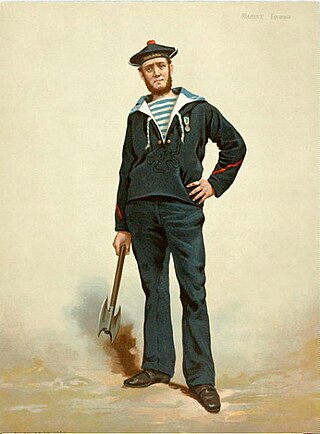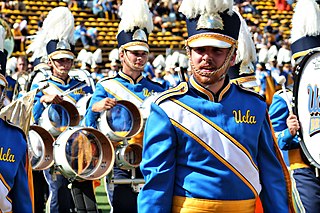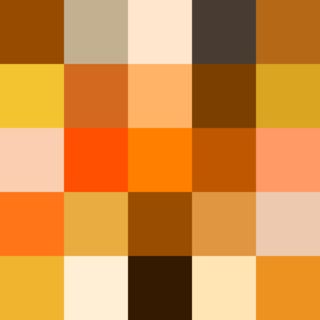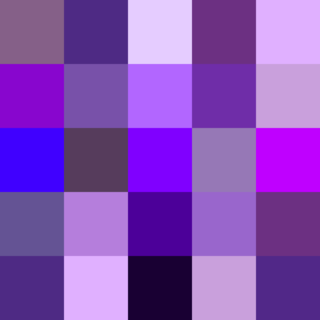Pantone LLC is an American limited liability company headquartered in Carlstadt, New Jersey, and best known for its Pantone Matching System (PMS), a proprietary color order system used in a variety of industries, notably graphic design, fashion design, product design, printing, and manufacturing and supporting the management of color from design to production, in physical and digital formats, among coated and uncoated materials, cotton, polyester, nylon and plastics.

Gold, also called golden, is a color tone resembling the gold chemical element.

Navy blue is a dark shade of the color blue.

School colors, also known as university colors or college colors, are the colors chosen by a school, academy, college, university or institute as part of its brand identity, used on building signage, web pages, branded apparel, and the uniforms of sports teams. They can promote connection to the school, known as "school spirit", and help differentiate it from other institutions.

Lavender is a light shade of purple or violet. It applies particularly to the color of the flower of the same name. The web color called lavender is displayed adjacent—it matches the color of the palest part of the flower; however, the more saturated color shown as floral lavender more closely matches the average color of the lavender flower as shown in the picture and is the tone of lavender historically and traditionally considered lavender by average people as opposed to website designers. The color lavender might be described as a medium purple, a pale bluish purple, or a light pinkish-purple. The term lavender may be used in general to apply to a wide range of pale, light, or grayish-purples, but only on the blue side; lilac is pale purple on the pink side. In paints, the color lavender is made by mixing purple and white paint.

Spring green is a color that was traditionally considered to be on the yellow side of green, but in modern computer systems based on the RGB color model is halfway between cyan and green on the color wheel.
Royal blue is a deep and vivid shade of blue. It is said to have been created by a consortium of mills in Rode, Somerset, which won a competition to make a robe for Queen Charlotte, consort of King George III. In winning the prize, a business in the village invented the dye and received a certificate to sell it under that name.
Columbia blue is a light blue color named after Columbia University. The color itself derives from the official hue of the Philolexian Society, the university's oldest student organization. Although Columbia blue is often identified with Pantone 292, the Philolexian Society first used it in the early 19th century, before the standardization of colors. Pantone 290, a slightly lighter shade of blue, has also been specified by some Columbia University offices, and is the current official color listed by the Columbia University visual communications office. Several other shades are also used by parts of the university in an official capacity.

In optics, orange has a wavelength between approximately 585 and 620 nm and a hue of 30° in HSV color space. In the RGB color space it is a secondary color numerically halfway between gamma-compressed red and yellow, as can be seen in the RGB color wheel. The complementary color of orange is azure. Orange pigments are largely in the ochre or cadmium families, and absorb mostly blue light.

Carolina blue is the shade of blue used as one of the official school colors of the University of North Carolina.

Cambridge Blue is the colour commonly used by sports teams from the University of Cambridge. There is contextual and historical variation. The colour used since the mid-20th century by Cambridge University Boat Club is greener than that used by Cambridge University R.U.F.C.. This rowing colour was created when Alf Twinn, the boatman from 1934 to 1984, added more yellow to this shade, reportedly to distinguish it from the rugby club's colour.

Varieties of the color green may differ in hue, chroma or lightness, or in two or three of these qualities. Variations in value are also called tints and shades, a tint being a green or other hue mixed with white, a shade being mixed with black. A large selection of these various colors is shown below.

Varieties of the color red may differ in hue, chroma, lightness, or in two or three of these qualities. Variations in value are also called tints and shades, a tint being a red or other hue mixed with white, a shade being mixed with black. A large selection of these various colors are shown below.

Duke blue is a dark blue color used in association with Duke University.

Pink colors are usually light or desaturated shades of reds, roses, and magentas which are created on computer and television screens using the RGB color model and in printing with the CMYK color model. As such, it is an arbitrary classification of color.

The color magenta has notable tints and shades. These various colors are shown below.

Varieties of the color yellow may differ in hue, chroma or lightness, or in two or three of these qualities. Variations in value are also called tints and shades, a tint being a yellow or other hue mixed with white, a shade being mixed with black. A large selection of these various colors is shown below.

Varieties of the color blue may differ in hue, chroma, or lightness, or in two or three of these qualities. Variations in value are also called tints and shades, a tint being a blue or other hue mixed with white, a shade being mixed with black. A large selection of these colors is shown below.

Violet is a color term derived from the flower of the same name. There are numerous variations of the color violet, a sampling of which are shown below.

Oxford Blue is the official colour of the University of Oxford. The official Oxford branding guidelines set its definition as Pantone 282, equivalent to the hex code #002147.









